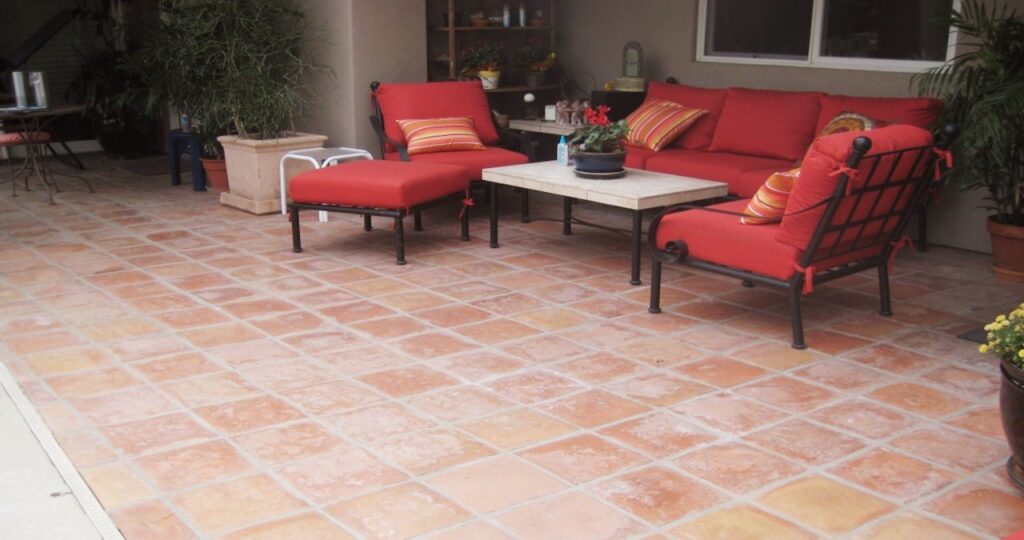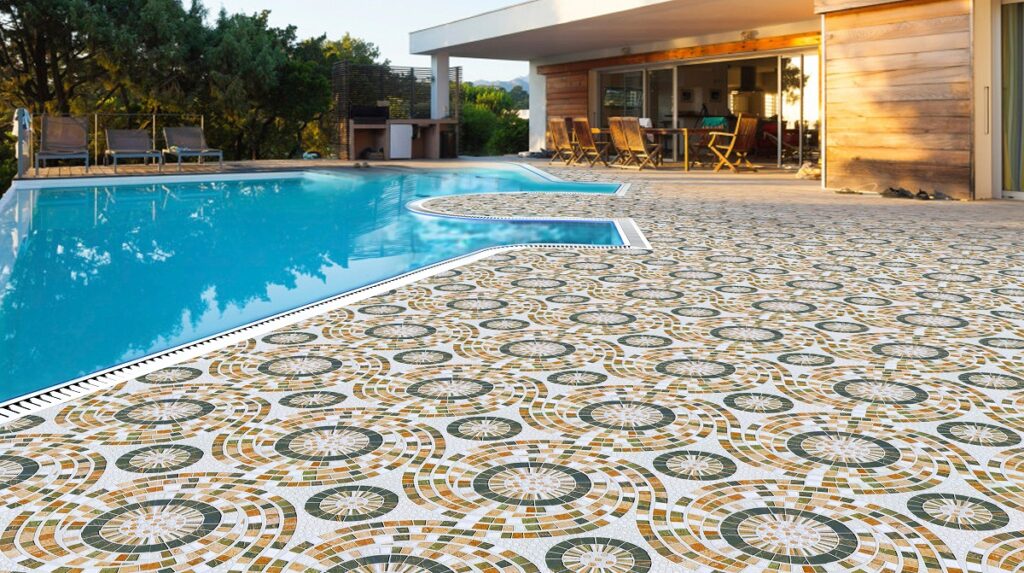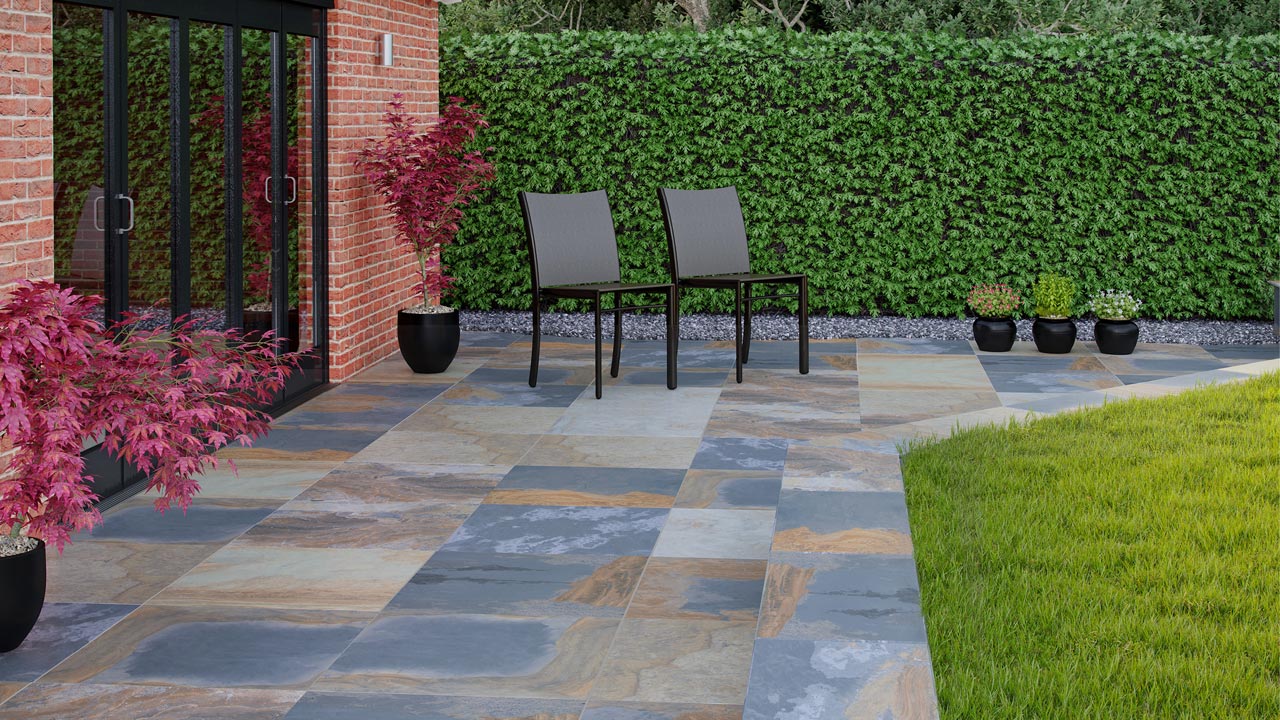If you’re interested in learning about the many varieties of outdoor tiles, you’ll find this article extremely beneficial. This is because we took the time to explain several outdoor tile options.
Slate
Slate is one of the finest natural stone options for outdoor patio areas. Slate is a metamorphic rock that was created under extreme pressure and heat. It is very tough and resilient, as well as highly resistant to water. And, unlike some other outdoor tiles, you may choose a product with a natural texture that makes it less slippery. Although many people think of slate as a dark gray or black stone, it comes in a variety of hues, including purple, green, and orange.
Granite
Another metamorphic natural stone that is sometimes used for patios, granite is a high-end, premium paving material that has certain limitations when used outside. Granite tile is often highly polished, making it slick when wet. Additionally, since it is a very porous stone in comparison to other types of tile, it will need frequent sealing to avoid stains and water penetration.
Limestone
Due to its relative availability and simplicity of production, limestone has been a preferred building material for millennia. The majority of limestone is found in different colours of tan, brown, red, or gray, with the lighter colors reflecting the most heat. Limestone is a softer stone than slate or granite, and as a result, it is more prone to scratching and chipping. Additionally, it must be sealed on a regular basis to avoid staining. It is better suited to patios in dry areas and is not recommended for locations with severe winters.
Soapstone
Soapstone is a non-porous natural stone that is extremely resistant to water and stains. It has a great resilience to heat, which makes it helpful in very hot areas. It is a great stone for usage around swimming pools and is resistant to moisture and cold temperatures.
Sandstone
Sandstone is another sedimentary rock that is much softer than limestone and has the same constraints. It is formed by layers of crushed sands over time and has an exquisite texture. However, it is highly delicate and scratch-prone, and must be sealed frequently to avoid stains and water penetration. This is another stone that is well-suited for patios in dry locations without freeze-thaw cycles throughout the winter.
Plastic outdoor tiles that Interlock
Plastic outdoor tiles with interlocking edges are a relatively new kind of tile. The benefit of these outdoor tiles is that the texture helps prevent slips and falls, and they are simple to install for do-it-yourselfers. Simply arrange them on a flat area and join the edges. Although this is not the most aesthetic patio option, it may be an effective method to cover an existing concrete slab patio that is in need of repair. They are incredibly robust and simple to remove if necessary. Perforations in the outdoor tiles enable water to drain through.
Decking outdoor tiles are big squares of wood or composite planking that are often fastened to backing strips and have interlocking edges. Decking tiles, which are often constructed of a weather-resistant wood such as cedar or redwood, replicate the look of a ground level deck without the requirement for an under-structure.

Rubber
Rubber outdoor tiles, which are often used for sports courts and other play areas, are similar to plastic interlocking tiles in that they include interlocking edges that connect to produce a homogeneous, robust surface. Rubber tiles with a very soft texture are offered for use in places where children play. Rubber tiles are another option for pool areas.
Concrete
Consider concrete outdoor tiles for an appearance similar to actual stone at a fraction of the expense. They are molded from poured concrete and given patterns and hues to imitate natural stone or high-end ceramic tile.
Carpet
Consider carpet outdoor tiles manufactured from indoor-outdoor carpeting for something entirely unique. The outdoor tiles may be peel-and-stick, affixed with adhesive tape, or feature interlocking edges, depending on the variety. They are simple to install on concrete slabs and quick to remove in the event that a tile requires replacement due to staining or breakage.
Costs
Cost estimation for a tile patio is challenging due to the large variety of materials available and regional variances in labor prices. However, natural averages demonstrate the following:
- Clay tile (porcelain, ceramic, or quarry): Materials cost between $2 and $30 per square foot, while labor costs between $4 and $14 per square foot.
- Natural stone tile: Materials cost between $5 and $35 per square foot, while labor costs between $8 and $20 per square foot. Sandstone, limestone, and travertine are less costly possibilities; soapstone, granite, and slate are more expensive.
- Synthetic and wood tile: Plastic, rubber, and carpet tiles cost approximately $3 per square foot on average; the majority of individuals install these materials themselves. On average, wood decking tiles cost between $8 and $12 per square foot, whereas composite decking outdoor tiles cost between $4 and $8 per square foot.

Getting help with your selection
When searching for outdoor patio tiles, consult a salesperson at a tile business. When describing your requirements, underline that the product will be used outside. There might be significant regional variance in terms of whether items are suitable for outdoor usage. In general, locations that are colder and more humid will have a smaller selection of materials, especially if there are frost-thaw cycles.
Your best option is to shop at a store that specializes in outdoor patio tile, preferably one that also provides installation services. Such a merchant will have a vested interest in the long-term viability of your installation and should guide you away from goods that are inappropriate for your application.
Additionally, an initial consultation with a landscape professional who specializes in outdoor tiles patio construction might be beneficial. Consult with the contractor to choose the kind of tile that is most suited for your scenario. Whether you decide to purchase services from the contractor or not, you will get a solid grasp of your alternatives.
Other articles good to read:
1. Effective ways to clean your outdoor tiles or pool tiles
2. Outdoor tiles vs indoor tiles

